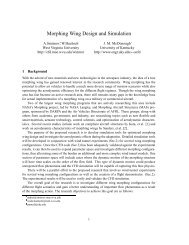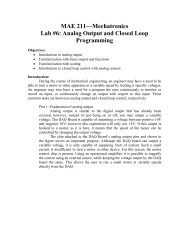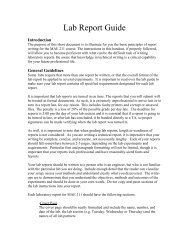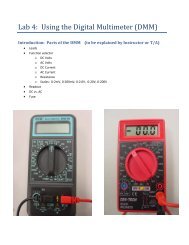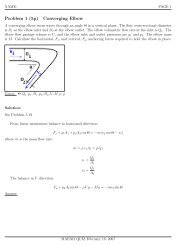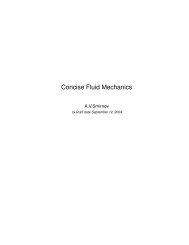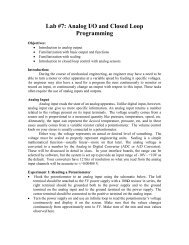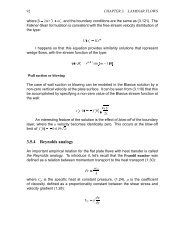Homework
Homework
Homework
- No tags were found...
You also want an ePaper? Increase the reach of your titles
YUMPU automatically turns print PDFs into web optimized ePapers that Google loves.
Chapter 1<br />
Mechanical Concepts<br />
Examples<br />
Example 1.1: Suppose I am building a gear train using 24-pitch gears. I want to use a 21-tooth<br />
gear to drive a 72-tooth gear. How far apart will the shafts centers be<br />
Solution: To find the distance apart, add half of the pitch diameter of both gears.<br />
Gear Pitch = # of teeth / Pitch Diameter<br />
24 pitch = 21 teeth / x inches x = .875 inches<br />
24 pitch = 72 teeth / y inches y = 3.00 inches<br />
(x + y) / 2 = 1.94 inches apart<br />
Example 1.2: Suppose I am building a gear train. I want to use a 21-tooth gear to drive a 72-<br />
tooth gear. What is the gear ratio<br />
Solution: Gear Ratio (N 12 ) = 21 teeth/72 teeth = .292<br />
Example 1.3: Assume that Gear A is the input and Gear D is the output. What is the gear ratio<br />
from A:D What is the direction of rotation of D with respect to that of A<br />
A<br />
(10 teeth)<br />
B<br />
(20 teeth)<br />
C<br />
(10 teeth)<br />
D<br />
(30 teeth)<br />
Solution:<br />
Gear Ratio (N AD ) = (10 teeth / 20 teeth) * (20 teeth / 10 teeth) * (10 teeth / 30 teeth)<br />
Gear Ratio (N AD ) = 1/3<br />
Gear D will turn the opposite direction of gear A.
Example 1.4: Now Gear B and Gear C are on the same shaft. Assume that Gear A is the input<br />
and Gear D is the output. What is the gear ratio from A:D What is the direction of rotation of D<br />
with respect to that of A<br />
A<br />
(10 teeth)<br />
C<br />
(10 teeth)<br />
D<br />
(30 teeth)<br />
B<br />
(20 teeth)<br />
Solution:<br />
Gear Ratio (N AD ) = (10 teeth / 20 teeth) *(1) * (10 teeth / 30 teeth)<br />
Gear Ratio (N AD ) = 1/6<br />
Gear D will turn the same direction of gear A.<br />
Example 1.5: Gear A is turning at 3450 rpm. What is the speed of Gear G What is the direction<br />
of rotation of G with respect to that of A<br />
A<br />
(10 teeth)<br />
C<br />
(10 teeth)<br />
D<br />
(10 teeth)<br />
E<br />
(10 teeth)<br />
G<br />
(30 teeth)<br />
B (20 teeth)<br />
F (20 teeth)<br />
Solution:<br />
Gear Ratio (N AG ) = (10 / 10) * (20 / 10) * (10 / 20) * (10 / 30) = 1/3<br />
Output Speed / Input Speed = N<br />
Output Speed / 3450 = 1/3<br />
Output Speed =1150 rpm<br />
Gear G will turn the same direction as gear A.<br />
Example 1.6: I have an I-beam that weighs 193 lbs. What is its mass<br />
Solution: F = m*a 193 lbs = m * 32.2 ft/s 2 m = 5.99 lbs * s 2 /ft = 5.99 slugs
Example 1.7: What torque is being applied to the nut<br />
Solution: T = F*R<br />
T = 159 lbs. * 8 inches = 106 ft lbs.<br />
Example 1.8: Gear A is turning at 1750 rpm and has a torque or 75 ft lbs. What is the speed and<br />
torque at gear D<br />
A<br />
(10 teeth)<br />
C<br />
(10 teeth)<br />
D<br />
(30 teeth)<br />
B (20 teeth)<br />
Solution:<br />
Gear Ratio (N AD ) = (10 teeth / 20 teeth) * (10 teeth / 30 teeth)<br />
Gear Ratio (N AD ) = 1/6<br />
Output Speed / Input Speed = N<br />
Output Torque / Input Torque = 1 / N<br />
Output Speed / 1750 rpm = 1/6 Output Torque / 75 ft lbs = 6<br />
Output Speed =292 rpm<br />
Output Torque = 450 ft lb<br />
Example 1.9: What is the gear ratio between the motor and gear D<br />
Motor<br />
Worm<br />
Gear<br />
A<br />
(10 teeth)<br />
C<br />
(10 teeth)<br />
D<br />
(30 teeth)<br />
B (20 teeth)<br />
Solution:<br />
Gear Ratio (N MD ) = (1 tooth / 10 teeth) (10 teeth / 20 teeth) * (10 teeth / 30 teeth)<br />
Gear Ratio (N MD ) = 1/60
Example 1.9 The sketch below shows a Lego motor set up to drive the carriage for a model X-Y<br />
plotter/recorder. All gears are modulus 1. If the motor turns 10 turns, how far does the<br />
carriage move<br />
Solution:<br />
The two spur gears have 20 teeth each. Since the worm gives a gear ratio of 1:N where N is the<br />
number of teeth of the spur, the spur gear turns:<br />
θ = (1/20)*(10 revolutions) = ½ revolution<br />
The distance moved will be<br />
S = πD<br />
θ<br />
p<br />
millimeters<br />
To find D, recall that modulus = (# teeth)/D in millimeters and these gears are modulus 1 so D =<br />
20 mm. Then S = 10 * π = 31.4 mm<br />
Example 1.10: Gear A is turning at 120 rpm counterclockwise and has a modulus of 2. Gear B is<br />
on the same shaft as a drum with a diameter of 75mm. A 12 kilogram mass is attached to a cable<br />
that wraps around the drum. How many revolutions of gear B will it take to lower the weight 100<br />
meters How long will it take What is the torque being applied by the weight to the shaft of gear<br />
A<br />
Gear A<br />
80 teeth<br />
Gear B<br />
120 teeth<br />
12 kg<br />
Solution:<br />
Gear A<br />
Gear B<br />
Modulus = # teeth/ pitch diameter<br />
Modulus = # teeth / pitch diameter<br />
2 = 80 teeth / pitch diameter 2 = 120 teeth / pitch diameter<br />
pitch diameter = 40 mm<br />
pitch diameter = 60 mm<br />
Gear Ratio<br />
Speed of Gear B
N = 80 teeth / 120 teeth<br />
N = 2/3<br />
Speed of gear A * gear ratio<br />
120rpm * 2/3 = 80rpm<br />
Time Calculation<br />
Weight of Mass<br />
F = m*a<br />
S = π *D* θ<br />
100 m = π * 75 mm * θ F = 12 kg * 9.81m/s 2<br />
θ = 424. revolutions<br />
424. revolutions / 80 rpm = 5.3 minutes<br />
Torque on shaft B from drum<br />
T = F * R<br />
T = 118 Newtons * (37.5mm)<br />
T = 4.43 Newton meters<br />
Torque on shaft A<br />
output torque / input torque = 1 / gear ratio<br />
4.43 Newton meters / input torque = 3 / 2<br />
input torque = 2.95 Newton meters<br />
F = 118. Newtons
<strong>Homework</strong>s<br />
1. Gear A is a 12 pitch, 28-tooth gear. It needs to be meshed with Gear B,<br />
whose shaft is 3.0in from shaft B. How many teeth should Gear B have<br />
2. A 40-tooth gear and a 16-tooth gear are both 12 pitch and need to be<br />
meshed. How far apart should the shafts be<br />
3. If a 108-tooth gear and a 36-tooth gear are meshed together, with a shaft<br />
distance of 2.25in, what is the pitch of the gears<br />
4. A=8-teeth, B=40-teeth, C=24-teeth, and D=40-teeth. The pitch diameter of<br />
gear A is 8mm. Gears B and C are on the same shaft. If block E is 0.5kg, what<br />
is the output torque, T D If the instantaneous velocity of block E is 0.75m/s, what<br />
is the speed of Gear D in rpm's<br />
A<br />
B<br />
C<br />
D<br />
E<br />
T D<br />
5. If the output torque M c must be 3M a , how many teeth should Gears B and C<br />
have Gear A has 26-teeth.<br />
A B C<br />
M<br />
a<br />
M c<br />
6. Set up a gear train, whose gear ratio is 2/15. You may choose from the<br />
following inventory of gears: one 8-tooth gear, one 16-tooth gear, one 24-tooth<br />
gear, one 40-tooth gear, and one 48 tooth gear. You do not have to use all of the<br />
gears.
Chapter 2<br />
Electricity<br />
Examples<br />
Example 2.1: Calculate the total resistance of the circuit shown below. (R1 is 100Ω, R2 is 100Ω,<br />
and R3 is 200Ω.)<br />
Solution: R eq = R1 + R2 + R3<br />
R eq = 100Ω + 100Ω + 200Ω = 400Ω<br />
Example 2.2: Calculate the total resistance of the circuit shown below. (R1 is 100Ω, R2 is 100Ω,<br />
and R3 is 200Ω.)<br />
Solution: 1/R eq = 1/R1 + 1/R2 + 1/R3<br />
1/R eq = 1/100Ω + 1/100Ω + 1/200Ω = .025<br />
R eq = 40Ω<br />
Example 2.3: Calculate the total resistance of the circuit shown below. (R1 is 100Ω, R2 is 100Ω,<br />
R3 is 200Ω, R4 is 300Ω, and R5 is 200Ω.)<br />
Solution: First compute the equivalent resistance of the series resistors (R4 and R5)<br />
R4 + R5 = 300Ω + 200Ω = 500Ω = R45<br />
Now, Compute the parallel resistance.<br />
1/R eq = 1/R1 + 1/R2 + 1/R3 + 1/(R45)<br />
1/R eq = 1/100Ω + 1/100Ω + 1/200Ω +1/500Ω = .027<br />
R eq = 37.04Ω
Example 2.4: Calculate the current at R1. (R1 is 200Ω.)<br />
Solution:<br />
You can use ohm’s law: I = V/R = 12 volts / 200Ω = 60 milliamps.<br />
Example 2.5: Calculate the current at R1. (R1 is 100Ω, R2 is 100Ω, and R3 is 200Ω.)<br />
Solution: You know that R eq of the circuit is 400Ω. (That’s 100 +100+200)<br />
So, you can use ohm’s law: I = V/R = 12 volts / 400Ω = 30 milliamps.<br />
Example 2.6: Calculate the current at each of the resistors. (R1 is 100Ω, R2 is 100Ω, R3 is<br />
200Ω, and R4 is 300Ω.)<br />
Solution: First, find the equivalent resistance of R2 and R4.<br />
1/R eq = 1/R2 + 1/R4 = 1/100 +1 / 300 R eq = 75Ω<br />
Voltage across R2 = [75Ω / (100Ω+75Ω+200Ω)] * 12 Volts = 2.4 Volts<br />
Voltage across R4 = Voltage across R2 = 2.4 Volts<br />
Now apply ohm’s law to R2 and R4:<br />
Ohm’s law at R2: I = V/R = 2.4 volts / 100Ω = 24 milliamps<br />
Ohm’s law at R4: I = V/R = 2.4 volts / 300Ω = 8 milliamps<br />
Now, (I at R1) = (I at R3) = (I at R2 + I at R4) = (24 milliamps + 8 milliamps) = 32 milliamps.<br />
Alternate Solution: To find I at R1 and R3, you could also have found the equivalent resistance of<br />
the entire circuit.<br />
R eq = R1 + [1/(1/R2 + 1/R4)] + R3 = 100 + [1/(1/100 + 1/300)] + 200 = 375Ω<br />
Then applied ohm’s law to the entire circuit<br />
I= V/R = 12V/375Ω = 32 milliamps So the current at R1 and R3 is 32 milliamps.
Example 2.7: Look at the schematic, what is the voltage change from point A to point B You<br />
know other voltage losses as follows: R2 (5 volts).<br />
Solution: 12 volts – 5 volts = 0<br />
R1 = 7 volts<br />
Example 2.8: Look at the schematic, what is the voltage change from point A to point B You<br />
know other voltage losses as follows: R1 (3 volts), R2 (5 volts), R4 (2.75 volts), and R5 (6 volts).<br />
Solution: 9 volts – 3 volts –5 volts –R3 – 2.75 volts + 9 volts –6 volts = 0<br />
R3 = 1.25 volts<br />
Example 2.9: Look at the schematic, what is the voltage change at R3 You know other voltage<br />
losses are as follows: R1 (5 volts), R2 (5 volts), R4 (2.75 volts), R6 (5 volts), R7 (3 volts), R8<br />
(1.25 volts), and R9 (4.5 volts).<br />
Solution:<br />
First, you need to apply KVL to the bottom loop to find the voltage change at R5.<br />
9 – R5 + 9 – 4.5 – 1.25 – 3 – 5 = 0<br />
R5 = 4.25 Volts dropped<br />
Now, you can apply KVL to the top loop to find the voltage change at R3.<br />
9 – 4.25 + 9 –5 – 5 – R3 – 2.75 = 0<br />
R3 = 1 Volts dropped
Example 2.10: Calculate the voltage across R1. (R1 is 100Ω, R2 is 100Ω, and R3 is 200Ω.)<br />
Solution: For this problem, you can use the voltage divider rule:<br />
Voltage across R1 = [100Ω / (100Ω+100Ω+200Ω)] * 12 Volts<br />
Voltage across R1 = 3 Volts<br />
Example 2.11: Calculate the voltage across each of the resistors. (R1 is 100Ω, R2 is 100Ω, R3<br />
is 200Ω, and R4 is 300Ω.)<br />
Solution: First, find the equivalent resistance of R2 and R4.<br />
1/R eq = 1/R2 + 1/R4 = 1/100 +1 / 300<br />
R eq = 75Ω<br />
Now, the voltage divider rule can be used:<br />
Voltage across R1 = [100Ω / (100Ω+75Ω+200Ω)] * 12 Volts<br />
Voltage across R1 = 3.2 Volts<br />
Voltage across R2 = [75Ω / (100Ω+75Ω+200Ω)] * 12 Volts<br />
Voltage across R2 = 2.4 Volts<br />
Voltage across R3 = [200Ω / (100Ω+75Ω+200Ω)] * 12 Volts<br />
Voltage across R3 = 6.4 Volts<br />
Voltage across R4 = Voltage across R2 because voltage is common in parallel<br />
Voltage across R4 = 2.4 Volts<br />
Example 2.12: Calculate the voltage across the combined resistors (R4 & R5) in circuit shown<br />
below. (R1 is 100Ω, R2 is 100Ω, R3 is 200Ω, R4 is 300Ω, R5 is 200Ω, and R6 is 150Ω.)<br />
Solution: First compute the equivalent resistance of the parallel resistors (R2 and R3)<br />
1/R eq =1/R2 + 1/R3<br />
R eq = 66.7Ω<br />
Now, use the voltage divider rule<br />
Voltage across (R4&R5) = [(200Ω+300Ω) / (100Ω+66.7Ω+300Ω+200Ω+150Ω)] * 12 Volts<br />
Voltage across R(4&5) = 7.35 Volts
Example 2.13: Suppose I have a 60-Watt light bulb in my desk lamp. A standard wall outlet<br />
produces 110 volts. How much current does it use<br />
Solution: Power=Voltage*Current<br />
60 Watts = 110 volts * I<br />
I = .545 amps<br />
Example 2.14: Find the power used by this circuit. (R1 is 100Ω, R2 is 100Ω, R3 is 200Ω, R4 is<br />
300Ω).<br />
Solution: First find the current from the battery.<br />
R eq = 375Ω<br />
Now, power = voltage * current<br />
I = V/R<br />
I =12V / 375Ω = 32mA<br />
Power = 12V * .032A = .384 Watts
<strong>Homework</strong>s<br />
Show work and include proper units with your answers. Round answers to 3 significant digits.<br />
#1. Determine the resistance between A and B for the following figures:<br />
1a) _________<br />
1b) _________<br />
1c) __________
1d) __________<br />
1e) __________<br />
2) Use Ohm’s Law to solve these:<br />
2a) Current in circuit ____________<br />
2b) Voltage at point B _____________
3) Determine the voltage of the battery in the following:<br />
3a) ____________<br />
3b) ____________<br />
3c) ____________
4) Determine the current at the given points for each of the following:<br />
4a) A=_________ B = ___________<br />
4b) A = _________ B = __________ C = __________
Chapter 3<br />
Binary/Decimal<br />
Example 3.1: Convert 69 to binary.<br />
Solution: 69 / 2 = 34 with a remainder of 1<br />
34 / 2 = 17 with a remainder of 0<br />
17 / 2 = 8 with a remainder of 1<br />
8 / 2 = 4 with a remainder of 0<br />
4 / 2 = 2 with a remainder of 0<br />
2 / 2 = 1 with a remainder of 0<br />
1 / 2 = 0 with a remainder of 1<br />
Now read the remainders from bottom to top: 1000101 2<br />
Example 3.2: Convert 69 to binary.<br />
Solution: 2 7 2 6 2 5 2 4 2 3 2 2 2 1 2 0<br />
128 64 32 16 8 4 2 1<br />
0 1 0 0 0 1 0 1<br />
1000101 2<br />
Example 3.3: Convert the Hex number E42A 16 to decimal.<br />
Solution: (14*16 3 ) + (4*16 2 ) + (2*16 1 ) + (10*16 0 ) = 58410<br />
Example 3.4: Convert 1628 to Hex.<br />
Solution: Method 1: 1628 / 16 = 101 with a remainder of 12<br />
101 / 16 = 6 with a remainder of 5<br />
6 / 16 = 0 with a remainder of 6<br />
Now read the remainders from bottom to top: 65C 16<br />
Method 2: 16 3 16 2 16 1 16 0<br />
4096 256 16 1<br />
0 6 5 12 (12 = C)<br />
So, again 65C 16
Example 3.5: Convert 10111010 2 to Hex.<br />
Solution: First, convert binary to decimal--<br />
(1*2 7 ) + (0*2 6 ) +(1*2 5 ) + (1*2 4 ) + (1*2 3 ) +(0*2 2 ) + (1*2 1 ) + (0*2 0 ) = 186<br />
Then, convert decimal to Hex—<br />
So, the answer is BA 16<br />
186 / 16 = 11 with a remainder of 10<br />
11 / 16 = 0 with a remainder of 11<br />
3.6:
<strong>Homework</strong>s<br />
1.) Convert the following binary numbers (base 2) to decimal (base 10):<br />
a.) 01101011<br />
b.) 101110<br />
c.) 11111<br />
2.) Convert the following binary number (base 2) to hex’ notation (base 16):<br />
a.) 11010101<br />
b.) 10011010<br />
c.) 11111110<br />
3.) Convert the following decimal numbers (base 10) to binary (base 2):<br />
a.) 64<br />
b.) 226<br />
c.) 24<br />
4.) Convert the following decimal number (base 10) to hex’ notation (base 16):<br />
a.) 1804<br />
b.) 13<br />
c.) 17<br />
5.) Convert the following hexadecimal notations (base 16) to decimal<br />
numbers(base 10):<br />
a.) A7<br />
b.) B2<br />
c.) 65<br />
6.) Convert the following hexadecimal notations (base 16) to binary<br />
numbers(base 2):<br />
a.) 1B<br />
b.) 45<br />
c.) AC




